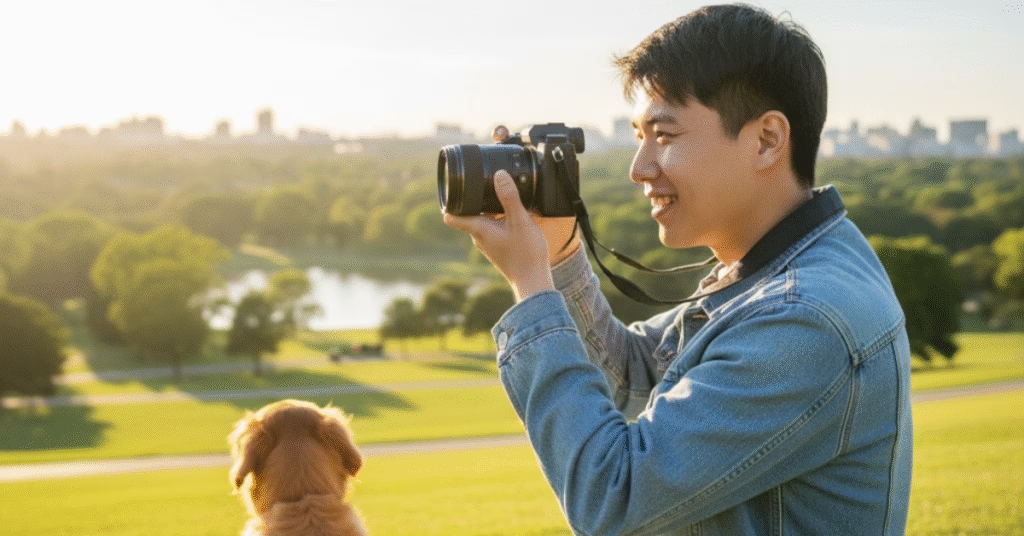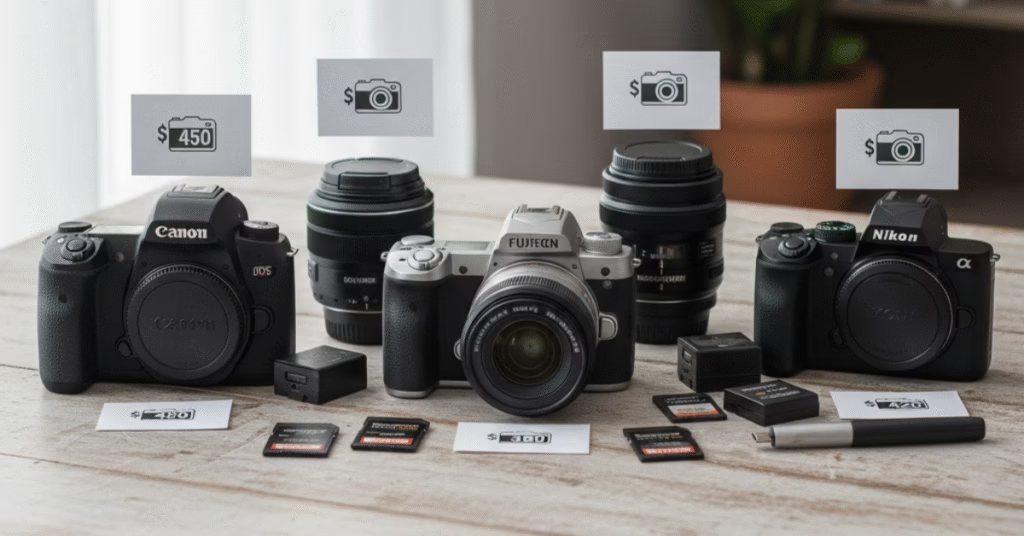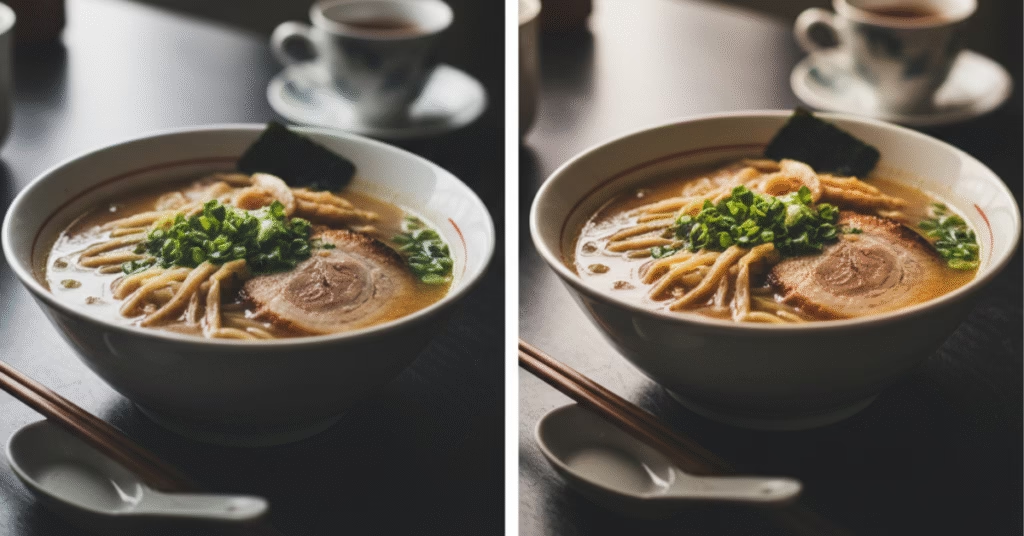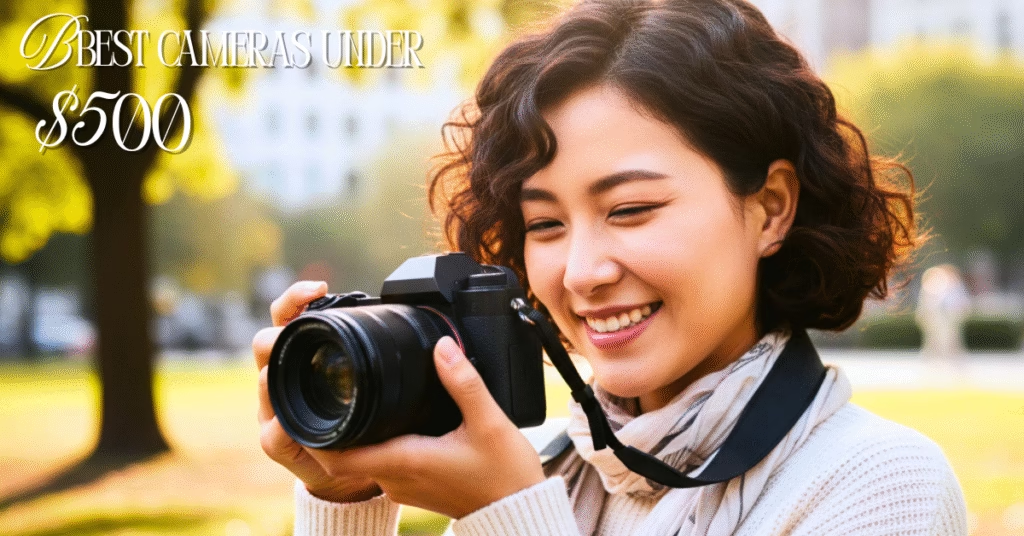Starting your photography journey is exciting, but choosing your first camera can feel overwhelming. The good news? You don’t need to spend thousands of dollars to get a camera that takes stunning photos! In fact, some of the best cameras for beginners are available for under $500, making photography accessible to everyone. Whether you’re interested in portraits, landscapes, or just capturing everyday moments, there’s an affordable camera for beginners that’s perfect for you. In this guide, we’ll show you the best budget cameras for beginners in 2025, what features to look for, and how to make a smart choice that will grow with your skills.
Why $500 is the Sweet Spot for Beginner Cameras
The under-$500 price range is ideal for beginners because it offers serious photographic capability without the intimidating cost of professional gear. These affordable cameras for photography give you manual controls to learn with, interchangeable lenses (in many cases), and image quality that far exceeds smartphones. Moreover, at this price point, you’re getting proven camera models that thousands of beginners have successfully learned on. You won’t outgrow these cameras quickly—many enthusiasts continue using them for years.
What to Look for in a Budget Camera for Beginners
Before diving into specific models, let’s understand what makes a camera worth your money as a beginner photographer.
Sensor Size and Image Quality
The sensor is the heart of any camera. Larger sensors generally produce better image quality, especially in low light. For beginner photography cameras under $500, you’ll typically find:
- APS-C sensors — Excellent image quality, found in most entry-level DSLRs and mirrorless cameras
- Micro Four Thirds — Slightly smaller but still very capable, with more compact body and lens options
- 1-inch sensors — Found in premium compact cameras, much better than phone cameras
Don’t worry too much about megapixels—anything over 16MP is plenty for beginners. Focus instead on sensor size and overall image quality.
Autofocus Performance
Good autofocus helps you capture sharp images quickly. Look for cameras with:
- Phase-detection autofocus (faster and more accurate)
- Face and eye detection (great for portraits)
- Continuous autofocus for moving subjects
Modern budget cameras have surprisingly good autofocus, making them excellent starter cameras for photography.
Ease of Use and Learning Curve
The best cheap cameras for photography balance simplicity with room to grow. Key features include:
- Intuitive menu systems
- Helpful guide modes for learning
- Physical dials for quick adjustments
- Touchscreen interface (increasingly common)
- Built-in tutorials or shooting tips
Video Capabilities
Even if you’re focused on still photography, decent video capability adds versatility. Most modern cameras in this range offer at least 1080p Full HD video, with many now featuring 4K. This makes them great budget cameras for photography and video.
Lens Ecosystem and Upgrade Path
If choosing an interchangeable lens camera, consider the available lenses:
- DSLR systems have decades of used lenses available
- Mirrorless systems are newer but growing rapidly
- Check the availability and cost of lenses you might want later
This is crucial for the best beginner cameras with interchangeable lenses.

Top Camera Categories Under $500
Let’s explore the different types of cameras available in this budget range and who they’re best for.
Entry-Level DSLR Cameras
DSLRs (Digital Single-Lens Reflex cameras) are traditional favorites for beginners. They offer:
Advantages:
- Optical viewfinder (no lag, works in bright sunlight)
- Excellent battery life (800+ shots per charge)
- Huge selection of affordable used lenses
- Familiar ergonomics and proven reliability
- Great for learning manual photography
Considerations:
- Bulkier and heavier than mirrorless alternatives
- Older technology in some models
- Slower live view autofocus
Best for: Beginners who value battery life, traditional handling, and access to abundant used lenses. Excellent entry-level DSLR cameras for those learning photography fundamentals.
Mirrorless Cameras for Beginners
Mirrorless cameras are the future of photography and increasingly affordable. They provide:
Advantages:
- Compact, lightweight design
- The electronic viewfinder shows exact exposure preview
- Faster and more accurate autofocus
- Better video capabilities
- Silent shooting modes
Considerations:
- Shorter battery life (200-400 shots typically)
- Smaller lens selection (though growing rapidly)
- An electronic viewfinder can lag in dim conditions
Best for: Beginners who want modern technology, travel photographers, and those interested in both photos and video. These are among the best mirrorless cameras for beginners on a budget.
Compact Cameras with Large Sensors
Premium compact cameras pack serious quality into a pocket-sized body:
Advantages:
- Ultra-portable, fits in jacket pocket
- Fixed lens means one less thing to worry about
- Often faster apertures than kit zoom lenses
- No dust issues from lens changes
Considerations:
- No lens interchangeability limits versatility
- Smaller sensors than DSLRs/mirrorless
- Limited zoom range (if any)
Best for: Travelers, street photographers, and beginners who want simplicity and portability. Great as a best point and shoot camera for beginners or as a complement to a smartphone.

Best Cameras Under $500: Our Top Picks
Here are the best budget-friendly cameras for beginners available in 2025, organized by category.
Best Entry-Level DSLR: Canon EOS Rebel T7 / 2000D
Price Range: $400-$450 with kit lens
The Canon Rebel T7 remains one of the most popular beginner DSLRs for good reason. This best Canon camera for beginners offers:
- 24.1MP APS-C sensor for excellent image quality
- 9-point autofocus system (adequate for beginners)
- Built-in Wi-Fi and NFC for easy photo sharing
- Feature Guide mode helps you learn settings
- 18-55mm kit lens covers most shooting situations
Why It’s Great for Beginners: Canon’s menu system is intuitive, the camera feels substantial in hand, and there’s an enormous selection of affordable Canon EF and EF-S lenses available used. Battery life is exceptional at 500+ shots. The Rebel T7 is a proven starter DSLR camera that thousands have learned on successfully.
Who Should Buy It: Beginners who want a traditional DSLR experience, excellent battery life, and access to Canon’s massive lens ecosystem.
Best Budget Mirrorless: Sony Alpha a6000
Price Range: $450-$500 body only (often with kit lens deals)
Despite being released years ago, the Sony a6000 remains a phenomenal value and one of the best Sony cameras for beginners:
- 24.3MP APS-C sensor with excellent image quality
- 179-point hybrid autofocus (incredibly fast)
- 11fps continuous shooting for action
- Built-in Wi-Fi for smartphone connectivity
- Compact body with excellent ergonomics
Why It’s Great for Beginners: The autofocus is shockingly good—better than cameras costing twice as much. The electronic viewfinder lets you see exactly how your exposure will look before shooting. Despite its age, image quality rivals current models, making it an affordable mirrorless camera for beginners that punches above its weight.
Who Should Buy It: Beginners who want cutting-edge autofocus, compact size, and a camera that can grow with them. Excellent for sports, wildlife, and action photography.
Best Nikon for Beginners: Nikon D3500
Price Range: $400-$480 with kit lens
The Nikon D3500 is arguably the most beginner-friendly DSLR ever made:
- 24.2MP APS-C sensor with great color rendering
- Superb battery life (1,550 shots per charge!)
- Guide Mode walks you through every setting
- Lightweight for a DSLR (only 415g body)
- SnapBridge Bluetooth for constant phone connection
Why It’s Great for Beginners: The Guide Mode is like having a photography teacher built into the camera. Battery life is nearly unbeatable. Nikon’s color science produces pleasing skin tones and landscapes straight out of camera. This is one of the best Nikon cameras for beginners who want something foolproof.
Who Should Buy It: Absolute beginners who want maximum hand-holding, anyone shooting long sessions without access to charging, and those who prefer Nikon’s color rendering.
Best Micro Four Thirds: Olympus OM-D E-M10 Mark II
Price Range: $350-$450 with kit lens (used/refurbished)
The Olympus E-M10 Mark II offers premium features at a budget price:
- 16.1MP Micro Four Thirds sensor
- 5-axis in-body image stabilization (rare at this price)
- Retro-styled metal body that feels premium
- Fast autofocus with 81 focus points
- 4K video capability
Why It’s Great for Beginners: The built-in image stabilization works with any lens you attach, letting you shoot sharp handheld photos in much lower light. The compact Micro Four Thirds system means small, affordable lenses. Olympus cameras have fantastic jpeg color straight from camera.
Who Should Buy It: Beginners who prioritize portability, want excellent image stabilization for video and low-light work, and appreciate a stylish camera that doesn’t scream “amateur.”
Best All-Rounder: Canon EOS M50 Mark II
Price Range: $500-$600 with kit lens (sometimes on sale under $500)
The Canon M50 Mark II bridges DSLR and mirrorless advantages:
- 24.1MP APS-C sensor
- Dual Pixel autofocus (excellent for video)
- Fully articulating touchscreen
- 4K video recording (with limitations)
- Built-in electronic viewfinder
Why It’s Great for Beginners: This camera excels at both photos and video. The vari-angle touchscreen makes shooting from creative angles easy. Canon’s Dual Pixel AF makes video autofocus smooth and professional-looking. It’s one of the best cameras for beginner photography and videography combined.
Who Should Buy It: Content creators, vloggers, and beginners who want one camera that does everything well. Perfect for social media creators and YouTube beginners.
Best Compact Option: Canon PowerShot G7 X Mark II
Price Range: $450-$550 (watch for sales)
For those wanting a premium compact, the G7 X Mark II delivers:
- 1-inch sensor (much larger than typical compacts)
- Bright f/1.8-2.8 lens (great in low light)
- Tilting touchscreen for selfies and vlogging
- Fits in a jacket pocket
- 1080p video with excellent quality
Why It’s Great for Beginners: No lens decisions to make—just point and shoot with far superior quality than any smartphone. The large aperture creates beautiful background blur for portraits. This best point and shoot camera for photography fits anywhere and shoots nearly as well as larger cameras.
Who Should Buy It: Travel photographers, street shooters, and beginners who want quality without the bulk. Great as a secondary camera or for those who know they won’t dive deep into lens systems.

New vs Used: Getting More Camera for Your Money
Your $500 budget goes much further if you’re willing to consider used or refurbished cameras. Here’s how to approach it:
Why Used Cameras Are Smart for Beginners
- Cameras don’t wear out like other electronics—shutter life is typically 100,000+ clicks
- You can afford a higher-tier model or add extra accessories
- Photography technology advances slowly; a 5-year-old camera still takes amazing photos
- More money left for lenses, which matter more than bodies
Where to Buy Used Safely
Reputable Sources:
- KEH Camera (graded condition, 180-day warranty)
- MPB (quality graded, 6-month warranty)
- B&H Used Department (inspected, returns accepted)
- Adorama Used (graded, warranty included)
- Local camera shops (test before buying)
What to Check:
- Shutter count (under 20,000 is excellent for beginners)
- Sensor condition (check for dust spots)
- All buttons and dials function properly
- Lens mount is clean and secure
- Battery holds charge
Used Models to Consider
At $500, you could get:
- Canon EOS 80D (originally $1,200)
- Sony a6300 (better specs than a6000)
- Nikon D7200 (semi-pro features)
- Fujifilm X-T20 (excellent image quality)
These are best used cameras for beginners that offer advanced features at entry-level prices.
Budget Allocation: Camera Body vs Lenses vs Accessories
Smart budgeting maximizes what you get from your $500. Here’s a recommended split:
If Buying Interchangeable Lens Camera
Option A: Start Simple ($500 total)
- $400 — Camera body with kit lens
- $50 — Extra battery and memory cards
- $30 — Basic camera bag
- $20 — Lens cleaning kit
This gives you everything to start shooting immediately.
Option B: Invest in Glass ($500 total)
- $350 — Camera body only (used)
- $100 — Quality prime lens (50mm f/1.8)
- $50 — Accessories and bag
Prime lenses teach composition and provide better image quality than kit lenses.
If Buying Compact Camera
Compact Setup ($500 total)
- $450 — Premium compact camera
- $30 — Extra battery
- $20 — Memory card and small case
With compacts, invest in the best body you can afford since lenses aren’t changeable.
Common Mistakes When Buying Your First Camera
Avoid these pitfalls that trip up many beginner photographers:
Mistake #1: Choosing Based on Megapixels Alone
More megapixels don’t automatically mean better photos. A 16MP camera with a good lens produces better images than a 30MP camera with a cheap lens. Focus on sensor size, autofocus, and overall system quality.
Mistake #2: Ignoring the Lens Ecosystem
That cheap camera body is less appealing when you discover lenses cost $500+ each. Research the available lenses before committing to a system, especially for best interchangeable lens cameras for beginners.
Mistake #3: Buying Too Much Camera
Features like dual card slots, weather sealing, and 20fps burst rates are overkill for beginners. You’ll learn faster with a simpler camera that doesn’t overwhelm you with options.
Mistake #4: Forgetting About Accessories
Don’t spend your entire budget on the camera body. You’ll need memory cards, an extra battery, and a bag at minimum. Budget at least $50-$100 for these essentials.
Mistake #5: Skipping the Kit Lens
Kit lenses (typically 18-55mm) are actually great learning tools. They cover useful focal lengths for most subjects and force you to learn composition before getting expensive lenses. Many best camera kits for beginners include a kit lens for good reason.
Camera Settings Beginners Should Master First
Once you have your camera, focus on learning these fundamentals:
Start with Automatic Modes (Don’t Be Shy!)
Use Program Auto (P) mode while learning your camera’s controls. There’s no shame in it—you’ll still get great photos while familiarizing yourself with the camera.
Master the Exposure Triangle
Understanding how these three settings work together is fundamental:
- Aperture (f-stop) — Controls depth of field and light
- Shutter Speed — Freezes or blurs motion
- ISO — Sensor sensitivity to light
Practice with Semi-Automatic Modes
- Aperture Priority (A/Av) — You control depth of field, camera adjusts shutter speed
- Shutter Priority (S/Tv) — You control motion blur, camera adjusts aperture
These modes teach you creative control while the camera helps with exposure.
Focus Modes to Understand
- Single AF — For still subjects (portraits, products)
- Continuous AF — For moving subjects (sports, wildlife)
- Manual Focus — For precise control (macro, night photography)
How to Test a Camera Before Buying
Whether buying new or used, test these functions:
In-Store Testing Checklist
- Hold and feel — Does it feel comfortable? Can you reach all controls?
- Check the viewfinder — Is it clear? Does it feel natural?
- Test the autofocus — Point at near and far objects; does it focus quickly?
- Review the menu system — Can you navigate it intuitively?
- Take test shots — Check image quality, color, and noise at high ISO
- Try different modes — Test auto, aperture priority, and manual modes
Questions to Ask the Seller (Used Cameras)
- What’s the shutter count?
- Why are you selling it?
- Are there any issues or quirks?
- What’s included (battery, charger, strap, caps)?
- Is there any warranty remaining?
- Can I test it thoroughly before buying?
Your Camera Will Grow With You
Remember: the best camera is the one you’ll actually use and learn from. All the cameras in this guide are capable of producing stunning images in the hands of someone who learns their craft. Your first camera is a learning tool, not your forever camera. As you discover your style—whether that’s landscapes, portraits, street photography, or something else—you’ll naturally understand what you need next.
Many professional photographers still occasionally use cameras in this price range for specific purposes. These aren’t “toy” cameras—they’re legitimate tools that teach you everything you need to know about photography.
Conclusion: Making Your Final Choice
Choosing the best cameras under $500 for beginner photographers comes down to your priorities:
- Want traditional reliability? Go with a DSLR like the Canon Rebel T7 or Nikon D3500
- Want modern features and compact size? Choose a mirrorless like the Sony a6000 or Canon M50 Mark II
- Want ultimate portability? Get a premium compact like the Canon G7 X Mark II
- Want the best value? Shop used for higher-tier models within budget
Whatever you choose, remember that learning photography is more important than the camera itself. Start with these affordable cameras for beginners, master the fundamentals, and upgrade only when you’ve outgrown what your camera can do. Most beginners discover they haven’t come close to using their camera’s full capabilities even after a year of shooting.
The best budget camera for photography is the one that excites you to go out and shoot. Choose wisely, start learning, and enjoy the journey!
Frequently Asked Questions
What is the best camera under $500 for a complete beginner?
The Canon EOS Rebel T7 and Nikon D3500 are excellent choices for absolute beginners. Both offer intuitive guide modes, great battery life, and user-friendly interfaces. If you prefer a mirrorless option, the Sony a6000 provides modern features with exceptional autofocus.
Should I buy a new or used camera as a beginner?
Used cameras are smart for beginners if purchased from reputable dealers like KEH, MPB, or B&H. You’ll get more features for your money, and cameras don’t wear out quickly. Just check the shutter count (under 20,000 is ideal) and ensure proper functionality before buying.
Is a DSLR or mirrorless camera better for beginners under $500?
Both are excellent choices. DSLRs offer better battery life, optical viewfinders, and more affordable used lenses. Mirrorless cameras are more compact, have better autofocus, and superior video capabilities. Choose based on whether you prioritize battery life and size (DSLR) or modern features and portability (mirrorless).
Do I need to buy extra lenses right away?
No. Start with the kit lens included with most beginner cameras. It covers versatile focal lengths (usually 18-55mm) perfect for learning. Once you’re comfortable, consider adding a 50mm f/1.8 prime lens as your first upgrade—it’s affordable and teaches excellent composition skills.
Can cameras under $500 shoot professional-quality photos?
Absolutely. Modern budget cameras have sensors and capabilities that professionals used just 10-15 years ago. Image quality depends more on your skills, lighting, and composition than camera cost. Many professional photographers still use budget cameras for specific projects.
What accessories should I budget for with my first camera?
Plan to spend $50-$100 on essential accessories: at least one extra battery ($20-$40), a quality memory card ($15-$30), a basic camera bag ($20-$40), and a lens cleaning kit ($10-$15). These protect your investment and keep you shooting.

I’m now not sure where yoou are getting your information, but good topic.
I must spend a while finding out more or figuring
ouut more. Thank you for great informatikn I
was in search of this information for my mission.
You are most welcome, you can contact me at anytime if you have any question or need any advice 💯